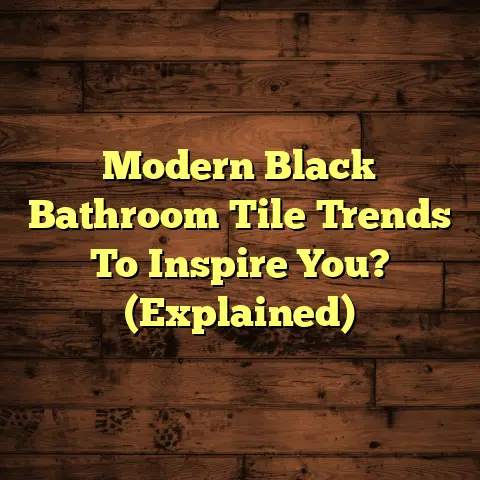Sealed vs. Unsealed Wood? (9 Must Know!)
Wood is the backbone of so many beautiful
homes and designs.
It’s warm, inviting,
and can last for generations… if you
treat it right.
One of the biggest decisions you’ll make when working with wood is whether to seal it or leave it unsealed.
It’s a question I get asked all the time, and honestly, it can make or break your project in terms of maintenance, aesthetics, and how long it lasts.
Think of it this way: sealed wood is like having a superhero suit on your furniture, while unsealed wood is more like embracing its natural, raw beauty.
But which one is right for you?
Let’s dive
into the nitty-gritty of sealed vs.
unsealed
wood so you can make the best choice for
your next project.
Section 1: Understanding Wood Finishing
So, what exactly is wood finishing?
Simply put, it’s the process of treating the surface of wood to protect it and enhance its appearance.
Without a finish, wood is vulnerable to all sorts of nasties: moisture, scratches, stains, you name it.
Think of wood finishing as the shield that protects your wooden treasures from the harsh realities of everyday life.
Sealing wood is a key part of this process.
Sealants are basically protective coatings
that create a barrier between the wood and
the outside world.
They prevent liquids from seeping in, block UV rays that can fade the color, and even make the surface easier to clean.
There’s a whole universe of wood finishes
out there, each with its own pros and cons.
Here are a few of the big players:
Oil-Based Finishes: These penetrate the wood, providing a warm, rich look.
They’re durable but can take longer to dry and may yellow over time.Water-Based Finishes: These are more eco-friendly, dry quickly, and don’t yellow.
However, they might not be as durable as oil-based finishes.Polyurethane Finishes: These create a tough, plastic-like coating that’s highly resistant to scratches and water.
They’re great for high-traffic areas but can look a bit artificial.
Section 2: The Characteristics of Sealed Wood
Sealed wood is like the ultimate survivor.
It’s got a tough exterior that can handle
almost anything you throw at it.
The biggest advantage of sealed wood is its resistance to water and stains.
That protective layer prevents liquids from soaking into the wood fibers, which can cause warping, rot, and unsightly blemishes.
I’ve seen countless kitchen countertops and bathroom vanities saved from disaster thanks to a good sealant.
Sealed wood is also incredibly durable.
That coating acts as a shield against
scratches, dents, and everyday wear and
tear.
This makes it ideal for high-traffic areas like floors, tables, and chairs.
You’ll find sealed wood everywhere, both indoors and outdoors. Think:
-
Indoor: Kitchen cabinets, hardwood floors, dining tables, bathroom vanities.
-
Outdoor: Decking, fences, outdoor furniture, siding.
Maintaining sealed wood is a breeze.
Usually, all you need is a damp cloth and
some mild soap to keep it looking its best.
Depending on the type of sealant used, you might need to reapply it every few years to maintain its protective properties.
Section 3: The Characteristics of Unsealed Wood
Now, let’s talk about the rebel of the wood
world: unsealed wood.
This is wood in its
natural, raw state, with no protective
coating whatsoever.
One of the biggest appeals of unsealed wood
is its breathability.
Because it’s not
covered in a sealant, the wood can absorb
and release moisture, which helps regulate
humidity levels in your home.
It also has a unique aesthetic appeal.
The
natural grain and texture of the wood are
on full display, giving it a warm, rustic
look that many people love.
However, unsealed wood comes with its own
set of challenges.
It’s highly susceptible
to moisture, stains, and wear and tear.
Spills can quickly seep into the wood,
leaving permanent marks.
And without a
protective coating, it’s more vulnerable to
scratches and dents.
I once had a client who insisted on using
unsealed wood for their kitchen island.
Within a few months, it was covered in water
rings and food stains.
We ended up having to sand it down and apply a sealant to salvage it.
You’ll often see unsealed wood used in:
- Rustic furniture
- Wooden toys
- Certain types of flooring (like unfinished hardwood)
- Decorative accents
Section 4: Comparing Durability and Longevity
When it comes to durability and longevity,
there’s a clear winner: sealed wood.
That
protective coating makes all the difference
in how well the wood stands up to the test
of time.
Unsealed wood, on the other hand, is much
more vulnerable to the elements.
Moisture
can cause it to warp, rot, and crack.
Sunlight can fade its color. And everyday use can lead to scratches and dents.
Here’s a quick comparison of how each type of wood reacts to various elements:
| Element | Sealed Wood | Unsealed Wood | | :——- | :——————————————————————————————————————————————————————————————————————————————————————————————————————————————————————————————————————————————————————————————————————————————————————————————————————————————————————————————————————————————————————————————————————————————————————————————————————————————————————————————————————————————————————————————————————————————————————————————————————————————————————————————————————————————————————————————————————————————————————————————————————————————————————————————————————————————————————————————————————————————————————————————————————————————————————————————————————————————————————————————————————————————————————————————————————————————————————————————————————————————————————————————————————————————————————————————————————————————————————————————————————————————————————————————————————————————————————————————————————————————————————————————————————————————————————————————————————————————————————————————————————————————————————————————————————————————————————————————————————————————————————————————————————————————————————————————————————————————————————————————————————————————————————————————————————————————————————————————————————————————————————————————————————————————————————————————————————————————————————————————————————————————————————————————————————————————————————————————————————————————————————————————————————————————————————————————————————————————————————————————————————————————————————————————————————————————————————————————————————————————————————————————————————————————————————————————————————————————————————————————————————————————————————————————————————————————————————————————————————————————————————————————————————————————————————————————————————————————————————————————————————————————————————————————————————————————————————————————————————————————————————————————————————————————————————————————————————————————————————————————————————————————————————————————————————————————————————————————————————————————————————————————————————————————————————————————————————————————————————————————————————————————————————————————————————————————————————————————————————————————————————————————————————————————————————————————————————————————————————————————————————————————————————————————————————————————————————————————————————————————————————————————————————————————————————————————————————————————————————————————————————————————————————————————————————————————————————————————————————————————————————————————————————————————————————————————————————————————————————————————————————————————————————————————————————————————————————————————————————————————————————————————————————————————————————————————————————————————————————————————————————————————————————————————————————————————————————————————————————————————————————————————————————————————————————————————————————————————————————————————————————————————————————————————————————————————————————————————————————————————————————————————————————————————————————————————————————————————————————————————————————————————————————————————————————————————————————————————————————————————————————————————————————————————————————————————————————————————————————————————————————————————————————————————————————————————————————————————————————————————————————————————————————————————————————————————————————————————————————————————————————————————————————————————————————————————————————————————————————————————————————————————————————————————————————————————————————————————————————————————————————————————————————————————————————————————————————————————————————————————————————————————————————————————————————————————————————————————————————————————————————————————————————————————————————————————————————————————————————————————————————————————————————————————————————————————————————————————————————————————————————————————————————————————————————————————————————————————————————————————————————————————————————————————————————————————————————————————————————————————————————————————————————————————————————————————————————————————————————————————————————————————————————————————————————————————————————————————————————————————————————————————————————————————————————————————————————————————————————————————————————————————————————————————————————————————————————————————————————————————————————————————————————————————————————————————————————————————————————————————————————————————————————————————————————————————————————————————————————————————————————————————————————————————————————————————————————————————————————————————————————————————————————————————————————————————————————————————————————————————————————————————————————————————————————————————————————————————————————————————————————————————————————————————————————————————————————————————————————————————————————————————————————————————————————————————————————————————————————————————————————————————————————————————————————————————————————————————————————————————————————————————————————————————————————————————————————————————————————————————————————————————————————————————————————————————————————————————————————————————————————————————————————————————————————————————————————————————————————————————————————————————————————————————————————————————————————————————————————————————————————————————————————————————————————————————————————————————————————————————————————————————————————————————————————————————————————————————————————————————————————————————————————————————————————————————————————————————————————————————————————————————————————————————————————————————————————————————————————————————————————————————————————————————————————————————————————————————————————————————————————————————————————————————————————————————————————————————————————————————————————————————————————————————————————————————————————————————————————————————————————————————————————————————————————————————————————————————————————————————————————————————————————————————————————————————————————————————————————————————————————————————————————————————————————————————————————————————————————————————————————————————————————————————————————————————————————————————————————————————————————————————————————————————————————————————————————————————————————————————————————————————————————————————————————————————————————————————————————————————————————————————————————————————————————————————————————————————————————————————————————————————————————————————————————————————————————————————————————————————————————————————————————————————————————————————————————————————————————————————————————————————————————————————————————————————————————————————————————————————————————————————————————————————————————————————————————————————————————————————————————————————————————————————————————————————————————————————————————————————————————————————————————————————————————————————————————————————————————————————————————————————————————————————————————————————————————————————————————————————————————————————————————————————————————————————————————————————————————————————————————————————————————————————————————————————————————————————————————————————————————————————————————————————————————————————————————————————————————————————————————————————————————————————————————————————————————————————————————————————————————————————————————————————————————————————————————————————————————————————————————————————————————————————————————————————————————————————————————————————————————————————————————————————————————————————————————————————————————————————————————————————————————————————————————————————————————————————————————————————————————————————————————————————————————————————————————————————————————————————————————————————————————————————————————————————————————————————————————————————————————————————————————————————————————————————————————————————————————————————————————————————————————————————————————————————————————————————————————————————————————————————————————————————————————————————————————————————————————————————————————————————————————————————————————————————————————————————————————————————————————————————————————————————————————————————————————————————————————————————————————————————————————————————————————————————————————————————————————————————————————————————————————————————————————————————————————————————————————————————————————————————————————————————————————————————————————————————————————————————————————————————————————————————————————————————————————————————————————————————————————————————————————————————————————————————————————————————————————————————————————————————————————————————————————————————————————————————————————————————————————————————————————————————————————————————————————————————————————————————————————————————————————————————————————————————————————————————————————————————————————————————————————————————————————————————————————————————————————————————————————————————————————————————————————————————————————————————————————————————————————————————————————————————————————————————————————————————————————————————————————————————————————————————————————————————————————————————————————————————————————————————————————————————————————————————————————————————————————————————————————————————————————————————————————————————————————————————————————————————————————————————————————————————————————————————————————————————————————————————————————————————————————————————————————————————————————————————————————————————————————————————————————————————————————————————————————————————————————————————————————————————————————————————————————————————————————————————————————————————————————————————————————————————————————————————————————————————————————————————————————————————————————————————————————————————————————————————————————————————————————————————————————————————————————————————————————————————————————————————————————————————————————————————————————————————————————————————————————————————————————————————————————————————————————————————————————————————————————————————————————————————————————————————————————————————————————————————————————————————————————————————————————————————————————————————————————————————————————————————————————————————————————————————————————————————————————————————————————————————————————————————————————————————————————————————————————————————————————————————————————————————————————————————————————————————————————————————————————————————————————————————————————————————————————————————————————————————————————————————————————————————————————————————————————————————————————————————————————————————————————————————————————————————————————————————————————————————————————————————————————————————————————————————————————————————————————————————————————————————————————————————————————————————————————————————————————————————————————————————————————————————————————————————————————————————————————————————————————————————————————————————————————————————————————————————————————————————————————————————————————————————————————————————————————————————————————————————————————————————————————————————————————————————————————————————————————————————————————————————————————————————————————————————————————————————————————————————————————————————————————————————————————————————————————————————————————————————————————————————————————————————————————————————————————————————————————————————————————————————————————————————————————————————————————————————————————————————————————————————————————————————————————————————————————————————————————————————————————————————————————————————————————————————————————————————————————————————————————————————————————————————————————————————————————————————————————————————————————————————————————————————————————————————————————————————————————————————————————————————————————————————————————————————————————————————————————————————————————————————————————————————————————————————————————————————————————————————————————————————————————————————————————————————————————————————————————————————————————————————————————————————————————————————————————————————————————————————————————————————————————————————————————————————————————————————————————————————————————————————————————————————————————————————————————————————————————————————————————————————————————————————————————————————————————————————————————————————————————————————————————————————————————————————————————————————————————————————————————————————————————————————————————————————————————————————————————————————————————————————————————————————————————————————————————————————————————————————————————————– Case Study:
I remember a time when a client of mine had installed a beautiful unsealed oak floor in their living room.
They loved the natural look, but within a year, they had a major problem.
Their dog had an accident, and the urine
soaked right into the wood, leaving a dark,
smelly stain that wouldn’t come out.
They
were devastated.
We ended up having to replace a large section of the floor, which was a costly and time- consuming process.
This is a prime example of why sealing wood is so important, especially in high-traffic areas or homes with pets.
Section 5: Aesthetic Considerations
Okay, let’s talk about looks.
Aesthetics are super important, and the choice between sealed and unsealed wood can have a huge impact on the overall feel of a space.
Sealed wood tends to have a smoother, more
polished appearance.
The finish can enhance
the wood’s natural grain and color, giving
it a rich, vibrant look.
However, some people find that sealed wood can look a bit too perfect or artificial.
Unsealed wood, on the other hand, has a more
rustic, natural charm.
The grain and texture
are more pronounced, and it has a warm,
earthy feel.
It’s perfect for creating a cozy, inviting atmosphere.
Ultimately, the choice comes down to personal preference and the overall design style you’re going for.
Do you prefer a sleek, modern look or a more rustic, natural vibe?
Here’s a quick guide to help you visualize the differences:
-
Sealed Wood: Think glossy hardwood floors, shiny kitchen cabinets, and sleek dining tables.
-
Unsealed Wood: Think reclaimed wood furniture, rustic wooden toys, and unfinished hardwood floors.
Section 6: Environmental Impact and Sustainability
In today’s world, it’s important to consider the environmental impact of our choices, and that includes wood finishes.
Sealed wood can have both positive and negative environmental implications.
On the one hand, some sealants contain volatile organic compounds (VOCs), which can contribute to air pollution.
However, there are also eco-friendly sealants available that are low in VOCs and made from sustainable materials.
Unsealed wood, on the other hand, is generally considered to be more environmentally friendly because it doesn’t require any chemical treatments.
However, it’s important to ensure that the wood is sourced from sustainably managed forests.
Look for certifications like the Forest Stewardship Council (FSC) to ensure that the wood is harvested responsibly.
I always recommend choosing eco-friendly
finishes whenever possible.
Look for
water-based sealants or natural oil finishes
that are low in VOCs.
These options are not only better for the environment but also for your indoor air quality.
Section 7: Cost Analysis
Let’s talk about money.
The cost of sealed vs.
unsealed wood can vary
depending on a number of factors, including
the type of wood, the quality of the sealant,
and the labor involved.
Generally speaking, unsealed wood is cheaper
to purchase upfront because it doesn’t require
any finishing.
However, you’ll need to factor
in the cost of maintenance over time.
Sealed wood, on the other hand, requires an initial investment in sealant and labor, but it can save you money in the long run by reducing the need for repairs and replacements.
Here’s a breakdown of the cost factors to consider:
-
Wood Species: Some wood species are more expensive than others.
-
Sealant Type: High-quality sealants can be pricey, but they’re worth the investment.
-
Labor Costs: If you’re hiring a professional to seal the wood, labor costs can add up.
-
Maintenance Costs: Unsealed wood requires more frequent cleaning and repairs, which can increase your overall costs.
Section 8: Installation and Preparation Techniques
Whether you choose sealed or unsealed wood, proper installation and preparation are key to achieving the best results.
For sealed wood, start by sanding the surface smooth and cleaning it thoroughly.
Then, apply the sealant according to the manufacturer’s instructions.
I always recommend applying multiple coats for maximum protection.
For unsealed wood, preparation is even more
important.
Make sure the wood is properly
dried and acclimated to its environment
before installation.
This will help prevent warping and cracking.
You’ll also want to apply a protective oil or wax to help repel moisture and stains.
Here are some essential tools and materials you’ll need:
- Sandpaper
- Paintbrushes or rollers
- Sealant or oil/wax
- Clean cloths
- Safety glasses and gloves
Section 9: Conclusion and Final Thoughts
So, there you have it: a comprehensive look
at the world of sealed vs.
unsealed wood.
As you can see, there’s no one-size-fits-all
answer.
The best choice depends on your
specific needs, preferences, and budget.
If you’re looking for durability, low maintenance, and resistance to water and stains, sealed wood is the way to go.
But if you prefer a natural, rustic look and are willing to put in the extra effort to maintain it, unsealed wood can be a beautiful choice.
Ultimately, the most important thing is to do your research, weigh your options, and choose the type of wood that’s right for you.
Happy woodworking!





